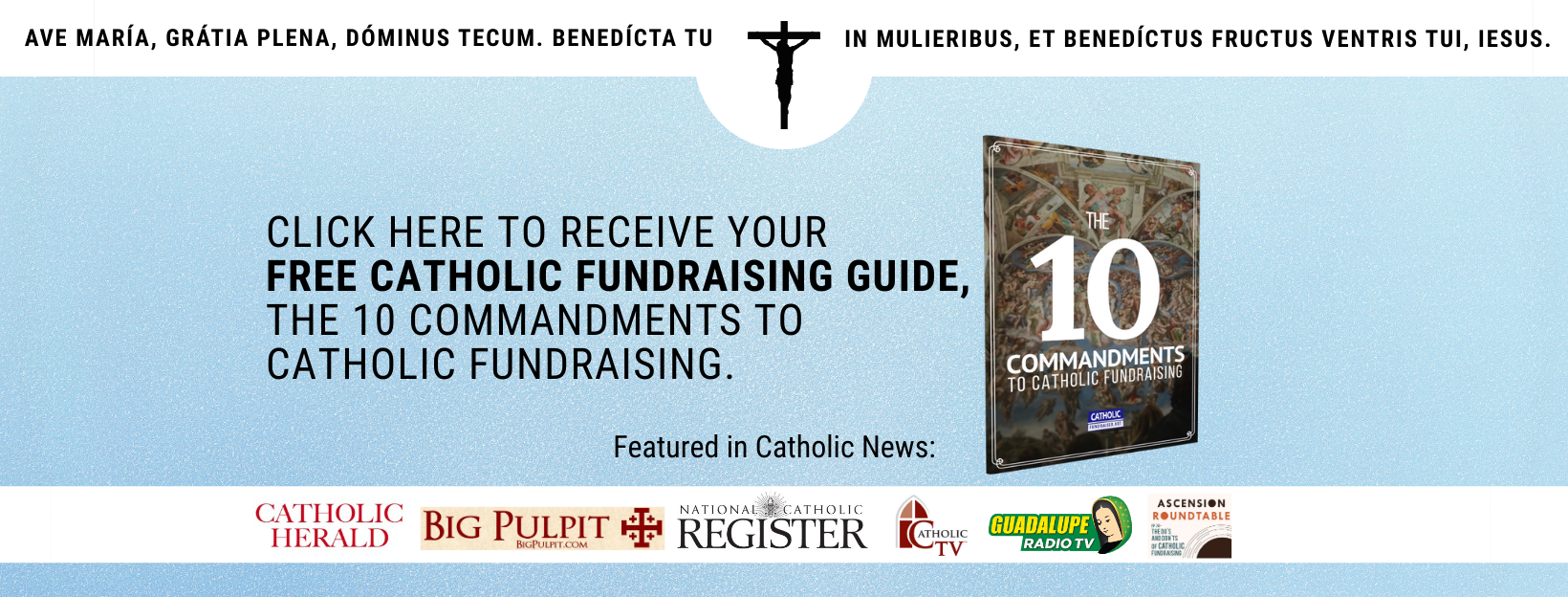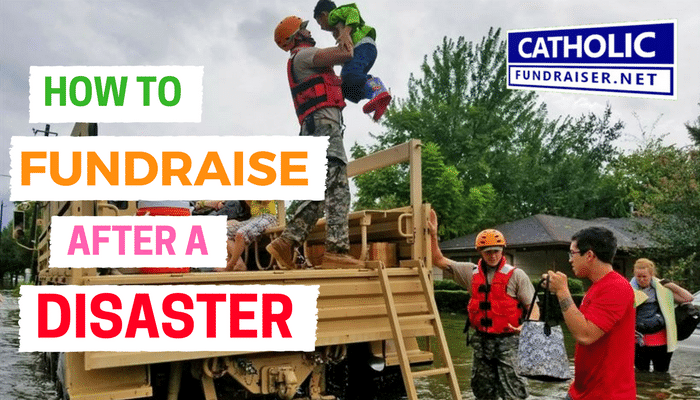You may already have a website or have been thinking of building one. Whatever the case, promoting your Catholic work online is one of the most significant steps you can make to attract prospects, find donors, and raise funds.
Just imagine how many more people could connect with your mission with a website? They could see photos of what you are doing, read stories about how you are changing lives, and engage in your work by attending an event, volunteering, and donating. Additionally, as a website is running 24/7, it can continuously promote you as you focus on your work.

However, you may think that building a website is not that straightforward. Computers and software may not be in your skill set. I agree. It can be quite daunting to learn about this brave new world, but you’ll be glad to hear that over the past few years, website building and maintenance have become much easier to manage, even for someone with minimal or no experience.
Just in case, if you have any questions about how powerful a website is for reaching people or want to know what Pope Paul VI said about how the Church must use social communications, read an article I wrote on the Misconceptions of the Internet.
I want to share with you 20 online tools that you can use to set up your website in less than a day. The tools will provide you with a fully functional site, and the best part, you will not have to spend thousands on development or software. In fact, most of the tools that I list are free and function with a few clicks of a mouse.
Website Hosting – Before you build a website, you must have a physical place to store it so people can find it and click through the pages. Think of hosting as the land which you build your house. A hosting service makes sure your website is available 24/7, allowing people to visit it anytime they wish. The two most popular hosting companies are Bluehost and Godaddy. Monthly service plans can start as low as $4.
Domain Name – You will have to give an address to your website which allows people to find you. Think of it as the post address which people can use to find you. I purchased www.catholicfundraiser.net for around $15/year. You can buy a domain directly through Bluehost or GoDaddy when you purchase hosting services. The benefit of doing this is the hosting service can directly link your domain (your address) name to your web hosting (your physical location).
Website Platform – You will then need a website platform that allows you to publish pages, posts, photos, media files, and anything else you want to show people. A web platform is also called a Content Management System. Think of it as your house which sits on the land you purchased (web hosting) and is found using the address (domain name). 20% of all websites run on WordPress, and I recommend you use this platform, too. It’s easy to use, familiar, and if you ever have issues, hosting services such as GoDaddy or Bluehost can help you resolve them immediately.
Website Theme – You will want to select the colors, fonts, styles, and formatting of your site so it matches your organization’s brand. The great news is you don’t have to pay a web developer thousands to edit code for you to get the look you want. You can avoid these costs by using services such as Optimizepress or Rainmaker which offers a variety of themes, Michael Hyatt’s Get Noticed theme is also a great option.
Web page Building – You can use services like LeadPages to design specific web pages for promoting an event or campaign. Their web building tools allow you to click and drag the different pictures, text, sections, and buttons to make the perfect page in minutes.
Social Sharing Buttons – It’s important to offer your readers the ability to share your content with their social networks. Research estimates that each person on Facebook is connected to 250 people. Therefore, you want to offer anyone who comes to your website the ability to share your content with their networks. Just imagine if 100 people shared one of your pages, another 25,000 other people would automatically see it. Therefore, having share buttons is an essential part of a website. I recommend using a tool called Sumome.
Email Gathering – 70% of all visitors to your website will never return. However, people who do visit your site may want to keep in touch with you via email. Research has found that email continues to be the number one most effective way (even beating social media platforms such as Facebook) to stay in touch with people. Therefore, you want to collect people’s emails when they visit your website. You can then send updates directly to their inbox. I suggest tools such as Mailchimp, Aweber, or Campaign Monitor.
Events – I recommend using Eventbrite to manage ticket sales, RSVPs, registration, and payments of your event. Eventbrite is one of the most popular event-planning platforms on the internet and is easily recognized and used by people. I also like this tool because it allows people to immediately place your event on their calendar. This way they don’t forget to come. They even offer a WordPress plug-in, allowing people to register directly on your website.
Social Media Posting – I recommend using tools such as Hootsuite or Buffer to publish your website content on your different social media channels. With a few clicks, you can post a photo, blog, or event on multiple social platforms (Pinterest, Instagram, LinkedIn, Twitter, and Facebook) from one of these tools, saving you the time and energy from going to each platform individually.
Design – Canva makes design simple for everyone. You can create in minutes beautiful infographics, presentations, Facebook and Twitter covers, flyers, posters, invitations and anything else you can imagine. Canva also offers a library of templates you can use to get you started.
Surveys – I have found one of the best ways to engage with people online is to ask them what they think. I use tools such as Google Forms or Surveymonkey to write surveys and questionnaires which help me learn what interests people. Their responses provide me the information to improve my content and engage with my audiences better.
Blog Commenting – The Disqus plugin allows people to comment on your blog posts, stories, and articles using their social profile (Facebook, Linkedin, Twitter). This is extremely useful because people can then automatically post what they said onto their social feeds. Their networks can then can read what they wrote and learn about your website.
Editing – I recommend using Grammarly to edit your stories, articles, and website text. The tool will check grammar, syntax, and even recommend different words to use so your writing flows better.
Payments and Online Donations – There are countless options for how to collect and process donations. I don’t recommend using a payment platform (apart from PayPal) that requires people to leave your website for theirs to complete the transaction. Research has shown that individuals who leave a site don’t complete the payment as often as if they had stayed on the original website. Rather, use these third party platforms for people who wish to sponsor an event on your behalf.
Instead, I recommend using Stripe, Samcart, Authorize.net, CommitChange, or E-Junkie, which all allow people to stay on your website to complete the transaction. Another benefit of completing the transaction on your site is that you can immediately direct the person to a thank you page and send them a thank you email. This dramatically helps the donor feel they’ve not only supported your work but has also deepened their relationship with you.
Live Chat – Online chat tools are gaining traction because they offer an excellent way to anyone visiting your website to ask a question directly. For example, if the person has difficulty finding information on your site, they can just type in the chat box their inquiry: “What time is Mass at St Mary’s Parish?”. You can then answer immediately, rather than through email which has a time detail. This tool makes you stand apart from every other organization’s websites which don’t often offer a personal level of interaction. You can use tools such as Drift, Olark, and Live Chat Inc.
Website Analysis – I recommend opening a Google Analytics account to monitor how people interact with your site. It’s important to know how people use your site, what they find interesting, and how they come to visit you. With this data, you can make regular adjustments to make your website even more appealing and useful to visitors. You can read this article for further instructions on how to leverage analytics on how to attract 1,000,000 people to your website .
Photos – There are several online libraries of free, high-quality photos. Just double check the usage rights as some ask that you make reference to the photographer and where you found the picture. I recommend the following sites: unsplash.com, pixabay.com, www.flickr.com, gratisography.com.
Video – I recommend not uploading your videos directly on your website because they will take up too much space and slow down how quickly your pages load. Instead, I suggest a tool that allows you to display the video on your pages without being saved on your site. You can use one of the following options: Vimeo, YouTube, Wistia, or Rawshorts if you want to add visual aids to your videos.
Relationship Management – Managing the relationships you have is one of the most important tasks you have in your organization, particularly fundraising. Whether someone is a donor, volunteer, or just a contact, you must be able to quickly and easily manage each person’s details and your relationship with them. I recommend using tools such as Salesforce or Infusionsoft.
My preference is to avoid tools unique to the charity sector because most become obsolete after 5 to 10 years, and it can be challenging to migrate all of your data onto another software. Also, most software solutions designed by the profit-sector integrate with nearly all other software, offering you a much longer-term solution.
Pop-up Windows – While pop-ups can be distracting, they do allow you to get people’s attention to specific information. You could notify them about an upcoming event, latest news, or a request to stay in touch. I do recommend learning how pop-ups can best help your organization interact with your website visitors. You can use tools such as Optinmonster, Rapidology, or if you are using LeadPages to build web pages, you have access to their library of pop-ups.
Question: What online tool do you currently find most useful on your website?
Please let me know what you think by leaving a comment below.
NOT SUBSCRIBED TO RECEIVE THE WEEKLY CONTENT? FIX THAT! IT’S COMPLETELY FREE.

*** REMEMBER TO CLICK THE SHARE BUTTONS AND TELL YOUR COLLEAGUES, PARISH LEADERS, PARISH PRIEST, AND OTHERS ABOUT THIS ARTICLE. THANK YOU. ***







